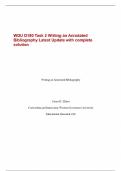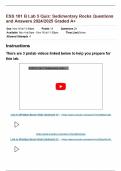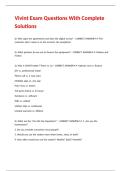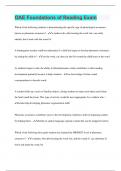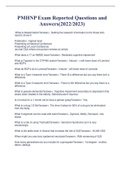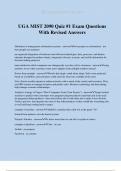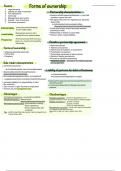KIN 313 FINAL PORTION
WHAT IS A - It is a late component of a stretch reflex occurring ~40ms after a perturbation is applied
PRE-PROGRAMMED - Include M2-3 amplitudes= actual pre programmed response
REACTION?
WHAT ARE THE - It is longer than a monosynaptic reflex but shorter than a voluntary reaction
CHARACTERISTICS OF A - Include 2 components: M2 and M3= corresponding to motor responses (representing bursts of
PRE-PROGRAMMED RXN? activity from action potentials)
- M2-3 are noted as pre-programmed responses
WHEN ARE M2-3 AMPLITUDES Large = M2 and M3 amplitudes are much larger when instructed to resist/oppose the effects of the
LARGE VS SMALL? perturbation= has voluntary component following M2-3 wave that is blended in with large M2/3 amplitude
- WHAT DO THEY
REPRESENT? smaller= M2 and M3 when told to relax/let go (allowing motor to stretch muscle)—becoming much smaller in
- WHEN DOES M1 VS amplitude= no voluntary rxn after
M2-3 OCCUR? **M1 for both is similar
- M2 and M3 can be hard to distinguish as M2 usually continues as M3 is initiated
- M1 is the initial monosynaptic reflex (20-25ms) in response to the stretch, has much smaller
amplitude than M2 and M3 (50-60ms)
WHAT IS M2-3 SENSITIVE TO? - Highly sensitive to the ‘set’ or ‘task’ (instruction)—accomplished by descending inputs that project
down into spinal MN pool
- Genetic disposition, characteristics of having webbed neck due to bilateral cortex projections
KLIPPEL FEIL SYNDROME - Cannot play piano, type —because projection for fine hand control goes bilaterally
- Study recording EMG in both arms
- When stimulus in one hand, longer monosynaptic response and bilateral response of muscles in
other hand
- M2 occurs in contralateral hand as well as ipsilateral hand
- No M1 in contralateral because motor neurons go back to SC and have one synaptic connection
with interneuron
**this is evidence that there is a transcortical component to pre-programmed responses
EVIDENCE OF SPINAL - Removing top part of cerebral hem from being involved in controlling anything below= many
CONTROL OF LOCOMOTION locomotor-like behavior remains, despite not being perfect
- When midbrain locomotor region stimulated =able to walk
Also..cutting through spinal cord around T6/7-12 in felines= cut out connection of lower limb from any
cortical control=
- Further seen in patients with complete/partial spinal cord injury=one shock can make legs have
reciprocal motions in bed, although minimally
- Indicative that circuitry for many rhythmic movements reside in spinal cord
CENTRAL RHYTHM - Study with use of paper drum , electrodes on paper that created burning on paper=electrodes
GENERATOR amplified by electricity from paper=further burning trace in paper
- When lesion in SC/cut dorsal roots= recording from gastrocs and give slight stim in SC= saw
activation of tbilisi anterior coming off=reciprocal activation of muscle around the joint
STEPPING IN CHRONIC - Record animal during walking on treadmill
SPINAL CAT - Create lesion in section of SC (complete spinal cord injury)—recording is almost identical 20 days
after lesion as prior to lesion =knee and ankle extensors working together and hip and knee flexors
working together
- Evidence of central pattern generator (network of interneurons somewhere in SC that drove the
pattern, independent of pain
, HALF CENTRE MODEL - One half is flexor half (i.e: a bunch of knee flexors)=controlling knees= brain
Network of interneurons in spinal cord that drives pattern independent of brain
- Incentive to flex =Excitatory interneuron told to fire AP= as burst is being sent to flexor MN, has
connection to interneuron in spinal cord (EPSP) projects to contralateral extensor half centre
=creates IPSP in opposite, preventing opposite side from coming on so flexion can go on first
- Also has recurrent loop on inhibitory interneuron that turns itself off, allowing other side to build its
activity
- In turn, when xtensor excitatory interneuron told to firs=sends burst to extensor MN and also has a
connection to interneuron in spinal cord, creating IPSP in contralateral, flexor side, preventing
flexor from coming on while extensor is on
Summary:
- Supraspinal input = gives command what to do to achieve a movement goal=get movement
- Also get sensory fb associated with limb doing movement (joint, GTO etc)
Losing supraspinal input via spinal cord lesion/injury
- Left with central pattern generator with sensory fb
EVIDENCE OF CENTRAL
PATTERN GENERATOR IN Walking infants study:
HUMANS - Babies normally take about a yr to start to walk as myelination still needs to be completed
- Anytime after 8m, if provide support for baby to balance, shows good preliminary stages of
locomotor control (spinal cord knows how to)—scaffold for locomotion exists in spinal cord
IMPORTANCE OF SENSORY FB
- For initiating walking ex: brushing cat on back = extends legs and starts walking
- Controlling phase transitions = stance to swing phase
- Regulating level of muscle activity (i.e: shifting to stand on one leg)
- Correcting for unexpected disturbances (i.e: stumbling-corrective responses such as when
slipping)
CONTROLLING PHASE How stance to swing transition goes (double support to flexion of R leg)
TRANSITIONS
- Stretch of hip flexors (info from muscle spindles builds up about hip extending far)
- At the same time, as body weight starts to get transferred, unloading of extensor muscles (via
GTOs)
- These proprioceptive inputs can initiate walking
EVIDENCE OF CONTROLLING Walking babies study —preventing hip extension
PHASE TRANSITIONS - Cardboard paper on treadmill, as treadmill moves, cardboard moves on top = one leg of baby is
placed over cardboard, other is not
- When leg hit cardboard, leg becomes stationary (stays in extension) = does most of weight baring
while left leg keeps moving
Stumbling corrective response
- Cat walking and comes in contact with bar—encounter obstacle during swing phase
- Once paw hits it, goes into flexion, goes over obstacle = then continues walking normally =
automatic flexion response
- Central pattern generator keeps going but integrates stumble correction due to afferent fb
- Called phase dependent reflex reversal
What happens if you stimulate - Response to obstacle depends on phase
your foot in the stance phase?
- Stim top of foot during swing = flexion of limb
- Stim top of foot during stance = get extension of limb
WHAT IS A - It is a late component of a stretch reflex occurring ~40ms after a perturbation is applied
PRE-PROGRAMMED - Include M2-3 amplitudes= actual pre programmed response
REACTION?
WHAT ARE THE - It is longer than a monosynaptic reflex but shorter than a voluntary reaction
CHARACTERISTICS OF A - Include 2 components: M2 and M3= corresponding to motor responses (representing bursts of
PRE-PROGRAMMED RXN? activity from action potentials)
- M2-3 are noted as pre-programmed responses
WHEN ARE M2-3 AMPLITUDES Large = M2 and M3 amplitudes are much larger when instructed to resist/oppose the effects of the
LARGE VS SMALL? perturbation= has voluntary component following M2-3 wave that is blended in with large M2/3 amplitude
- WHAT DO THEY
REPRESENT? smaller= M2 and M3 when told to relax/let go (allowing motor to stretch muscle)—becoming much smaller in
- WHEN DOES M1 VS amplitude= no voluntary rxn after
M2-3 OCCUR? **M1 for both is similar
- M2 and M3 can be hard to distinguish as M2 usually continues as M3 is initiated
- M1 is the initial monosynaptic reflex (20-25ms) in response to the stretch, has much smaller
amplitude than M2 and M3 (50-60ms)
WHAT IS M2-3 SENSITIVE TO? - Highly sensitive to the ‘set’ or ‘task’ (instruction)—accomplished by descending inputs that project
down into spinal MN pool
- Genetic disposition, characteristics of having webbed neck due to bilateral cortex projections
KLIPPEL FEIL SYNDROME - Cannot play piano, type —because projection for fine hand control goes bilaterally
- Study recording EMG in both arms
- When stimulus in one hand, longer monosynaptic response and bilateral response of muscles in
other hand
- M2 occurs in contralateral hand as well as ipsilateral hand
- No M1 in contralateral because motor neurons go back to SC and have one synaptic connection
with interneuron
**this is evidence that there is a transcortical component to pre-programmed responses
EVIDENCE OF SPINAL - Removing top part of cerebral hem from being involved in controlling anything below= many
CONTROL OF LOCOMOTION locomotor-like behavior remains, despite not being perfect
- When midbrain locomotor region stimulated =able to walk
Also..cutting through spinal cord around T6/7-12 in felines= cut out connection of lower limb from any
cortical control=
- Further seen in patients with complete/partial spinal cord injury=one shock can make legs have
reciprocal motions in bed, although minimally
- Indicative that circuitry for many rhythmic movements reside in spinal cord
CENTRAL RHYTHM - Study with use of paper drum , electrodes on paper that created burning on paper=electrodes
GENERATOR amplified by electricity from paper=further burning trace in paper
- When lesion in SC/cut dorsal roots= recording from gastrocs and give slight stim in SC= saw
activation of tbilisi anterior coming off=reciprocal activation of muscle around the joint
STEPPING IN CHRONIC - Record animal during walking on treadmill
SPINAL CAT - Create lesion in section of SC (complete spinal cord injury)—recording is almost identical 20 days
after lesion as prior to lesion =knee and ankle extensors working together and hip and knee flexors
working together
- Evidence of central pattern generator (network of interneurons somewhere in SC that drove the
pattern, independent of pain
, HALF CENTRE MODEL - One half is flexor half (i.e: a bunch of knee flexors)=controlling knees= brain
Network of interneurons in spinal cord that drives pattern independent of brain
- Incentive to flex =Excitatory interneuron told to fire AP= as burst is being sent to flexor MN, has
connection to interneuron in spinal cord (EPSP) projects to contralateral extensor half centre
=creates IPSP in opposite, preventing opposite side from coming on so flexion can go on first
- Also has recurrent loop on inhibitory interneuron that turns itself off, allowing other side to build its
activity
- In turn, when xtensor excitatory interneuron told to firs=sends burst to extensor MN and also has a
connection to interneuron in spinal cord, creating IPSP in contralateral, flexor side, preventing
flexor from coming on while extensor is on
Summary:
- Supraspinal input = gives command what to do to achieve a movement goal=get movement
- Also get sensory fb associated with limb doing movement (joint, GTO etc)
Losing supraspinal input via spinal cord lesion/injury
- Left with central pattern generator with sensory fb
EVIDENCE OF CENTRAL
PATTERN GENERATOR IN Walking infants study:
HUMANS - Babies normally take about a yr to start to walk as myelination still needs to be completed
- Anytime after 8m, if provide support for baby to balance, shows good preliminary stages of
locomotor control (spinal cord knows how to)—scaffold for locomotion exists in spinal cord
IMPORTANCE OF SENSORY FB
- For initiating walking ex: brushing cat on back = extends legs and starts walking
- Controlling phase transitions = stance to swing phase
- Regulating level of muscle activity (i.e: shifting to stand on one leg)
- Correcting for unexpected disturbances (i.e: stumbling-corrective responses such as when
slipping)
CONTROLLING PHASE How stance to swing transition goes (double support to flexion of R leg)
TRANSITIONS
- Stretch of hip flexors (info from muscle spindles builds up about hip extending far)
- At the same time, as body weight starts to get transferred, unloading of extensor muscles (via
GTOs)
- These proprioceptive inputs can initiate walking
EVIDENCE OF CONTROLLING Walking babies study —preventing hip extension
PHASE TRANSITIONS - Cardboard paper on treadmill, as treadmill moves, cardboard moves on top = one leg of baby is
placed over cardboard, other is not
- When leg hit cardboard, leg becomes stationary (stays in extension) = does most of weight baring
while left leg keeps moving
Stumbling corrective response
- Cat walking and comes in contact with bar—encounter obstacle during swing phase
- Once paw hits it, goes into flexion, goes over obstacle = then continues walking normally =
automatic flexion response
- Central pattern generator keeps going but integrates stumble correction due to afferent fb
- Called phase dependent reflex reversal
What happens if you stimulate - Response to obstacle depends on phase
your foot in the stance phase?
- Stim top of foot during swing = flexion of limb
- Stim top of foot during stance = get extension of limb

